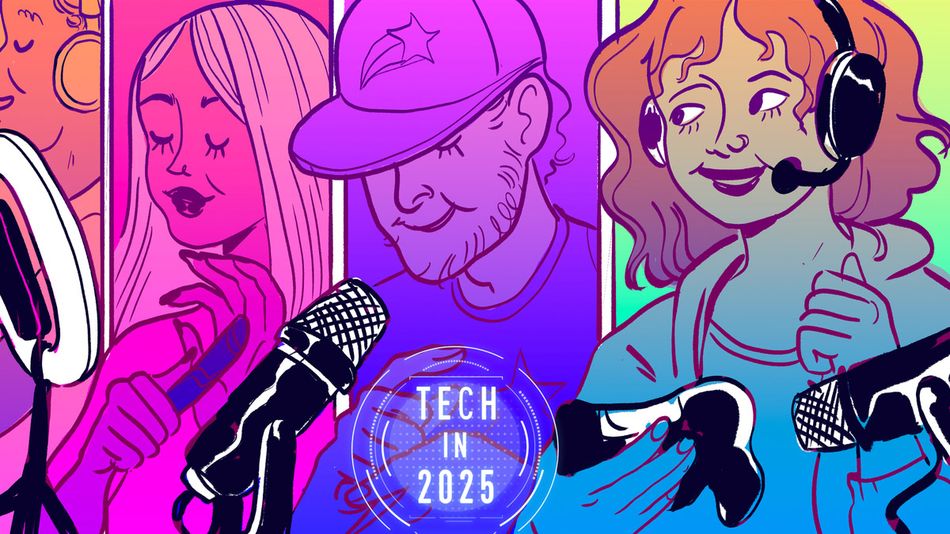Technology
The livestreaming boom isn’t slowing down anytime soon

Mashable’s series Tech in 2025 explores how the challenges of today will dramatically change the near future.
Whether people are creating or consuming it, streaming content has been a prime source of escapism for many during the pandemic.
But is the livestreaming boom temporary? Or will it keep going strong, say, five years down the line?
I spoke with dozens of people to find out. There’s the startup software developer who completed 45 livestreams (so far!) since the pandemic began. Alastair Jolly, global marketing manager of Flickr, told me the business just started livestreaming with customers for the first time. There are artist collectives, fitness gurus, and musicians streaming to connect with customers and fans. I even talked to a church-goer whose women’s group started meeting virtually.
Each one of them insisted that livestreaming will continue to be part of their future.
“Imagine this pandemic happening 20 years ago, before mass broadband and the kind of services and content and applications that are now available. I mean, where would we be?” said Eli Noam, a professor at the Columbia Business School.
For Noam, who is also the director of the Columbia Institute for Tele-Information, the real-world cases like the ones mentioned above cement livestreaming as the future, even after the pandemic. Why wouldn’t an artist continue to livestream events when live concerts begin? It lets them reach people (and their wallets) in cities and small towns they would never visit on tour.
“I was not able to find a webcam anywhere.”
The real question, Noam said, is what livestreaming will do to our social patterns.
If a church, for example, continues to livestream services after the pandemic, will the elderly, sick, and people with children just find it easier to attend virtually? Will people participate in more services because it’s easier to attend from the comfort of home?
“Maybe the churches will be emptier but people’s religious lives will actually be enriched,” Noam said.
The pandemic didn’t create livestreaming. The technology and the platforms were already there. It was just growing at a much, much slower pace.
“This is not temporary, the temporary situation is the accelerant,” explained Noam, stressing how livestreaming was already on the rise before the pandemic.
“These transitions are happening just faster because of the pandemic virus,” he explained. “It’s not just livestreaming either. Other things like work from home, online education, doctor’s visits, all kinds of things were happening already. Now they’re happening faster and they’re not going to go back to the status quo.”
The livestreaming boom
“Never before has the world taken video and live video so seriously,” said Luria Petrucci, a live video strategist for streaming consultant firm .
Since the pandemic, she says she’s worked with “thousands of people who never intended to use video or livestreaming.” Then the pandemic came and forced those same people to “get over their fears” of getting behind a camera and going live.
The numbers show the livestreaming boom is real.
In March, when lockdowns in the U.S. began, users of Amazon-owned livestreaming service Twitch watched 1.1 billion hours of content, according to , which makes software to manage and enhance streams. The next quarter, Twitch with 3 billion hours.
A report from Streamlabs found similar growth on Facebook’s video game streaming platform, which tripled its viewing numbers from the previous year, hitting 822 million hours watched.
People love to put on the TV, curl up on the couch, and watch their favorite cable show. More people are doing the same for livestream feeds. By treating live online video just like any other TV programming, people are normalizing the experience. YouTube says it saw a 250 percent increase in the amount of time people watched live content on their TV screens in March.
“Imagine this pandemic happening 20 years ago, before mass broadband …where would we be?”
The growth in livestreaming since the pandemic has been “exponential,” said John Petrocelli, the founder and CEO of livestreaming firm Bulldog Media, and a 20-year veteran of the industry.
“As recently as 2 to 3 years ago we were still conducting information sessions, awareness briefings … with marketers and advertisers about the introduction of livestreaming,” he said. “That has all changed now and it’s expected that any experience of any significance will have a livestream strategy.”
Ecamm Live, a livestreaming app for Mac, experienced “over 200 percent membership growth” since the pandemic began, said Katie Fawkes, the company’s digital marketing manager. “In February 2020, we had roughly 35,000 livestreams, and by end of July, we were seeing over 1 million livestreams.”
And half a year into the pandemic, microphones, green screens, and webcams are still in high demand and low supply.
“I was not able to find a webcam anywhere,” cosplay streamer Anja Takera told me in late May.
Logitech, the leading webcam manufacturer, told me at the time that the company had “aggressively increased production to focus on more quantities of webcams in order to meet the demand.” Some of the company’s most popular webcams, like the c920 and c922, are still sold out at Amazon and Best Buy.
Why livestreaming will continue to grow
The equipment issue will (hopefully!) be solved soon. But you now have a hell of a lot of people invested in the livestreaming space. Those content creators are unlikely to stop anytime soon.
Petrucci of Live Streaming Pros pointed out another reason why the slew of new livestreamers aren’t going anywhere: it’s now a vital part of their companies. While streaming may have been a fun, gimmicky add-on to their business model before, it’s now a necessary way to communicate to their customers and audience.
There’s another factor that will buoy livestreaming for years to come, according to Bull Dog Media’s Petrocelli: advertising.
“This is not temporary, the temporary situation is the accelerant.”
He said cord cutting — cancelling your cable subscription — and technology like ad blockers have been challenging for the ad industry. How do brands reach viewers if more and more people aren’t watching traditional TV or are actively avoiding advertisements?
“Livestreams can address these issues while delivering the holy grail to marketers: engagement or watch time,” he said.
The habit of watching on-demand streams could stick with viewers, some of whom will eventually seek out content from livestreamers on Twitch and YouTube.
Viral video platforms that are popular with younger audiences, such as and , have been focusing on their livestream products. And Zoom experienced a in popularity during the pandemic. All of it has normalized livestreaming as a regular activity.
“Last year, most people in the ‘real world’ still didn’t know what livestreaming was,” Petrucci told me. That, obviously, has changed.
Fawkes of Ecamm explained how the pandemic brought a big shift in the types of audiences using its app to stream, with more churches, musicians, teachers, businesses, and podcasters deciding to step in front of the camera.
“When COVID hit,” said Fawkes, “video in all forms became less of a ‘nice to have’ and is now a ‘must have’ as businesses and individuals from all types of industries need to connect with their audiences and customers in order to survive.”
-
Politics6 days ago
Facebook oversight board debuts, but no decisions before Election Day
-
Technology7 days ago
Researchers created a sleep-tracking device designed to alter dreams — Future Blink
-
 Technology7 days ago
Technology7 days agoInstagram, YouTube, and more (UK deal)
-
Technology7 days ago
Twitter is still letting you retweet. You don’t have to quote tweet.
-
Technology5 days ago
PayPal terminates account of Epik, home to Proud Boys domain and Gab
-
Entertainment6 days ago
How Netflix’s “Rebecca” ending is different from the book
-
Entertainment5 days ago
Everything coming to HBO Max in November 2020
-
Featured3 days ago
Over in minutes: Special Boat Service’s ‘textbook’ raid shows why they have fearsome reputation | UK News


